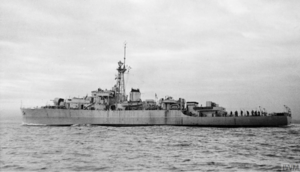SAS Good Hope
 HMSAS Good Hope, Loch Class frigate at sea in 1945
| |
| History | |
|---|---|
| Name | Loch Boisdale |
| Namesake | Lochboisdale |
| Ordered | 28 December 1942 |
| Builder | Blyth Harbour and Dock Company, Blyth, Northumberland |
| Laid down | 8 November 1943 |
| Launched | 5 July 1944 |
| Fate | Transferred to the South African Navy, 9 November 1944 |
| Name | Good Hope |
| Namesake | Cape Province |
| Completed | 1 December 1944 |
| Acquired | 9 November 1944 |
| Commissioned | 9 November 1944 |
| Decommissioned | 1978 |
| Fate | Scuttled 12 December 1978 |
| General characteristics (as built) | |
| Class and type | Loch-class frigate |
| Displacement |
|
| Length | 307 ft (93.6 m) |
| Beam | 38 ft 7 in (11.8 m) |
| Draught | 12 ft 4 in (3.8 m) |
| Installed power |
|
| Propulsion |
|
| Speed | 20 knots (37 km/h; 23 mph) |
| Range | 9,500 nmi (17,600 km; 10,900 mi) at 12 knots (22 km/h; 14 mph) |
| Complement | 114 |
| Sensors and processing systems | |
| Armament |
|
SAS Good Hope (pennant number: F432) was one of three Loch-class frigates in the South African Navy (SAN). It was built as HMS Loch Boisdale (K432) for the Royal Navy during World War II, but was transferred to the SAN before completion in 1944 and renamed as HMSAS Good Hope. The ship was assigned to convoy escort duties in 1945, but did not encounter any enemy ships before the end of the war.
It was assigned to ferry troops home from
Middle Africa in 1948. Upon returning home, Good Hope was placed in reserve until it was converted into a training ship during the mid-1950s and served as the navy's flagship. The ship was again placed in reserve in 1965 and was sold for scrap in 1977. Good Hope's remains were donated for use as an artificial reef and it was scuttled
the following year.
Description
Good Hope displaced 1,435 long tons (1,458 t) at
In preparation for her reclassification as a
Construction and career
Good Hope was built by
Western Approaches Command; it was damaged during its first mission and required a month to repair the storm damage. Good Hope rejoined the 18th Escort Group which was covering convoys between England and France until the German surrender in May. It was then refitted for tropical duties before sailing for South Africa on 6 June 1945 with its sister ship, Natal, with 29 ex-prisoners of war aboard the sisters. They arrived on 30 June, but Good Hope was not sent to the Far East because the Japanese surrendered before it was ready to go.[7]
Good Hope and her sisters Natal and
hulk was donated to the False Bay Conservation Society for use as an artificial reef.[8] She was scuttled in False Bay on 12 December 1978.[9]
Notes
References
- "Good Hope (6118133)". Miramar Ship Index. Retrieved 30 March 2016.
- Chesneau, Roger, ed. (1980). Conway's All the World's Fighting Ships 1922–1946. Greenwich, UK: Conway Maritime Press. ISBN 0-85177-146-7.
- ISBN 978-1-86176-281-8.
- ISBN 1-874800-50-2.
- Lenton, H. T. (1998). British & Empire Warships of the Second World War. Annapolis, Maryland: Naval Institute Press. ISBN 1-55750-048-7.
- Moore, John, ed. (1974). Jane's Fighting Ships 1974–75. London: Macdonald and Jane's. ISBN 0-531-02743-0.
External links
Wikimedia Commons has media related to F432 Good Hope (ship, 1943).
- Flag-showing cruises of the South African Navy Archived 28 May 2019 at the Wayback Machine
